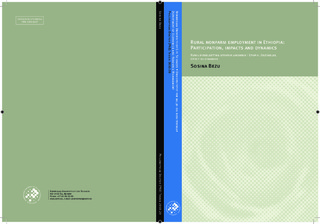| dc.contributor.advisor | Holden, Stein T. | |
| dc.contributor.advisor | Barret, Christopher B. | |
| dc.contributor.author | Bezu, Sosina | |
| dc.coverage.spatial | Ethiopia | nb_NO |
| dc.date.accessioned | 2017-02-23T13:04:00Z | |
| dc.date.available | 2017-02-23T13:04:00Z | |
| dc.date.issued | 2010 | |
| dc.identifier.isbn | 978-82-575-0931-6 | |
| dc.identifier.issn | 1503-1667 | |
| dc.identifier.uri | http://hdl.handle.net/11250/2431922 | |
| dc.description.abstract | This thesis consists of four papers analyzing the different facets of rural nonfarm employment in Ethiopia. The analyses in this thesis are mainly based on panel data of more than 1400 rural household in Ethiopia. The papers in this thesis make an extensive use of various econometric methods for the analyses.The first paper identify the different types of nonfarm activities and analyze the factors behind rural households’ choice among these nonfarm activities. It was shown that some nonfarm activities yield superior returns while others yield a return very close to farm wage employment. Capacity is the most important determinant of participation in high-return activities while the lowreturn activities are driven by need. The second paper investigates the impact of participation in a particular nonfarm activity, food-for-work (FFW), on agricultural investmetnt. Participation in FFW was found to positively influence fertilizer adoption and there was no evidence for disincentive effect. The third paper examines whether nonfarm participation goes beyond increasing current consumption to offer a way for upward mobility. The results indicate that nonfarm participation improves income dynamics. An increase in the nonfarm share of income leads to higher rates of growth in consumption expenditure. The fourth papers evaluates how the nonfarm employment portfolio of rural households evolve over time, especially focusing on whether poor households in low-return employment eventually access high-return activities and how the high-return employments are affected by shock experiences. The results suggest that low-return participants who accumulated asset and have access to saving are eventually able to enter high-return activities. High-return activities are robust to health shocks but not to shocks that affect their liquidity. | nb_NO |
| dc.language.iso | eng | nb_NO |
| dc.publisher | Norwegian University of Life Sciences, Ås | nb_NO |
| dc.relation.ispartofseries | PhD Thesis;2010:20 | |
| dc.rights | Attribution-NonCommercial-NoDerivatives 4.0 Internasjonal | * |
| dc.rights.uri | http://creativecommons.org/licenses/by-nc-nd/4.0/deed.no | * |
| dc.title | Rural nonfarm employment in Ethiopia : participation, impacts and dynamics | nb_NO |
| dc.title.alternative | Rural sysselsetting utenfor landbruk i Etiopia : deltakelse, effekt og dynamikk | nb_NO |
| dc.type | Doctoral thesis | nb_NO |
| dc.subject.nsi | VDP::Social science: 200::Economics: 210::Economics: 212 | nb_NO |
| dc.source.pagenumber | 162 | nb_NO |

